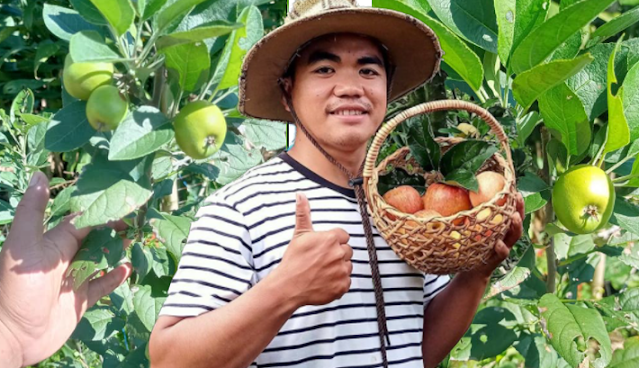Benzone Sepe has proven that apple farming in the Philippines is possible. His farm now has over 300 apple trees.
In 2014, Benzone Sepe planted three seeds in their backyard in Barangay Kapatagan, Digos, while eating an apple.
Two plants died after a few months, while the only one that survived could not bear fruit.
Benzone did not stop there as he conducted further research on apple farming.
In an interview with ABS-CBN News, he said he pruned the plant, but it didn’t end there. “I found out on the internet that the branch should be bent for sunlight exposure,” he said.
Benzone first noticed flowers on the apple tree in January 2018, and the following month, he discovered four pinkish and fist-sized apples hanging from it.
He said it still has the same juiciness and crunchiness as a commercial apple.

Dr. Alexander Campaner, an agriculturist, says an apple grows best at a temperature between 7 and 12 degrees Celcius.
Campaner said apple trees were planted in Benguet, but the results were not as good as ours.
As a result, apple trees could grow in Digos’ highlands.
This is Mindanao’s first flourishing apple tree, according to Bong O’ate of the Department of Agriculture XI.
Growing apples (Malus domestica) in a tropical country like the Philippines might be tricky. However, living in Kapatagan, Digos City, Davao del Sur, where the climate is cool, makes it ideal.
He took three seeds from an apple he had eaten seven years ago, planted them in seashells, and then moved them to seedling bags when they reached approximately five inches tall. The 30-year-old student started cultivating apples out of sheer curiosity seven years ago. Even though all seeds sprouted, only one tree survived after Sepe planted the young apple seedlings in the ground at six months.
After visiting Korea, he was determined to cultivate apples. After reading local magazines about farmers growing mangoes in greenhouses, he wondered if apples could be grown there. As a result, he returned home and began researching apple gardening after seeing an apple tree blossom in his backyard.
Sepe began harvesting apples from his apple tree in September 2018. Each harvest yields 30 to 35 fruits.
Managing his apple farming business
Sepe now has over 250 to 300 apple trees. He grows this fruit in three separate areas: a 600 square meter backyard, in front of his church, and on a half-hectare piece of land he rents.
In temperate climates, apple trees bear fruit after five to seven months, according to Sepe. In his area, however, it only takes four months for apple trees to begin producing fruit. According to Sepe, it may be difficult to grow apples in the Philippines, but it is possible. However, the grower stated that apple seeds have a very low germination rate and are resistant to fungus. As a result, you must plant more and take many risks.
“If you want to start growing apples from seeds, you should plant as many as possible, 100 or more apple seeds,” Sepe explained to The Manila Bulletin.
Sepe uses Integrated Pest Management (IPM), which includes homemade natural pesticides and foliar sprays to control pests on his land.
When he needs help, Sepe hires part-timers.
The Apple Orchard, Rare Fruit Farm, and Nursery at Kapatagan
Sepe grows a variety of apples, including Fuji, Golden Dorsett, Starking, Granny Smith, Gala, Redlove Odysso, and Russet.
Sepe grows a variety of apples, including Fuji, Golden Dorsett, Starking, Granny Smith, Gala, Redlove Odysso, and Russet.
In addition to apples, Sepe grows pear, persimmon, peach, Hass avocado, orange, durian, grapes, strawberry, guava, and vegetables in his orchard.
As the Philippines’ first ATI-certified Learning Site for Agriculture (LSA) for apple production, Kapatagan Apple Orchard, Rare Fruit Farm, and Nursery welcomes visitors and students interested in apple cultivation.
See Also:
- ASF in Antique: San Jose Prohibits Backyard Slaughter of Hogs
- African Swine Fever in Zambales: Candelaria Steps Up Biosecurity Measures vs. ASF
- Chinese Tourists Land in Jail for Damaging Choral Reefs in Thailand
- Pinanga Subterranea: New Rare Palm Species Found to Flower Underground
- DBM: New Slaughterhouse in Ormoc City to Strengthen Meat Industry
